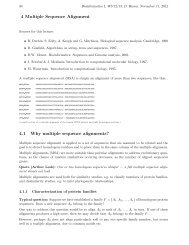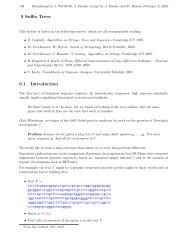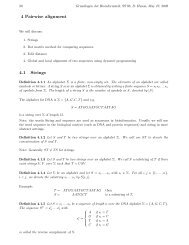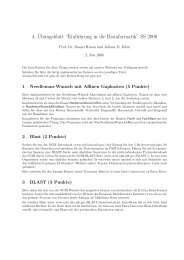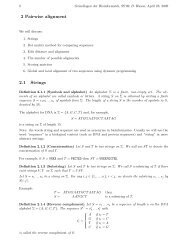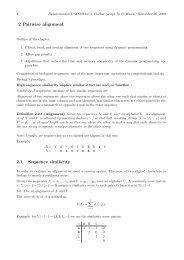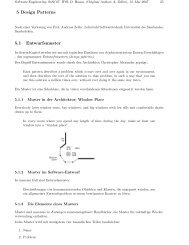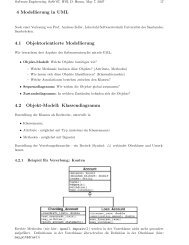4 Multiple Sequence Alignment 4.1 Multiple sequence alignment
4 Multiple Sequence Alignment 4.1 Multiple sequence alignment
4 Multiple Sequence Alignment 4.1 Multiple sequence alignment
Create successful ePaper yourself
Turn your PDF publications into a flip-book with our unique Google optimized e-Paper software.
Grundlagen der Bioinformatik, SS’09, D. Huson, May 10, 2009 37What happens when we add a new <strong>sequence</strong>? If the number of aligned <strong>sequence</strong>s is small, then wewould not be too surprised if the new <strong>sequence</strong> shows a different residue at the previously constantposition i.However, if the number of <strong>sequence</strong>s is large, then we would expect the constant position i to remainconstant, if possible.Unfortunately, the SP score favors the opposite behavior: the more <strong>sequence</strong>s there are in an MSA, theeasier it is, relatively speaking, for a differing residue to be placed in an otherwise constant column.⎧⎧A ∗ 1 = . . . x . . .A ∗⎪⎨ A ∗ 1 = . . . x . . .2 = . . . x . . .⎪⎨ A ∗ 2 = . . . x . . .Consider L = . . .and R = . . .A ⎪⎩∗ r−1 = . . . x . . .A ⎪⎩∗ A ∗ r−1 = . . . x . . .r = . . . x . . .A ∗ r = . . . y . . .The SP-score of the column in L iss SP (x r ) =( r2)s(x, x).The SP-score of the column in R is( ) r − 1s SP (x r−1 , y) = s(x, x) + (r − 1)s(x, y).2So, the difference between s SP (x r ) and s SP (x r−1 , y) is:( ( )r r − 1s(x, x) − s(x, x) − (r − 1)s(x, y) = (r − 1)(s(x, x) − s(x, y)).2)2Therefore, the relative difference iss SP (x r ) − s SP (x r−1 , y) (r − 1)(s(x, x) − s(x, y))s SP (x r =)r(r − 1)/2 s(x, x)= 2 ( )s(x, x) − s(x, y),r s(x, x)which decreases as the number of <strong>sequence</strong>s r increases!4.3.3 TreesWe briefly introduce trees. We will consider them in more detail later.Definition 4.3.2 (Tree) A tree T is a finite, connected graph without cycles. Nodes of degree 1 arecalled leaves. A rooted tree T is a tree for which we chosen one node to be the root. In a rooted treeall edges are directed away from the root.rootA.ceranaExample:a leafancestorA.koschevA.dorsataA.floreadescendantA.andrenofA.melliferDefinition 4.3.3 (Phylogenetic tree) Let X be a set of taxa. A phylogenetic tree T is a tree,whose leaves are labeled bijectively by the elements of a set X.If all internal vertices (except the root) have degree 3, then T is called a binary phylogenetic tree.




